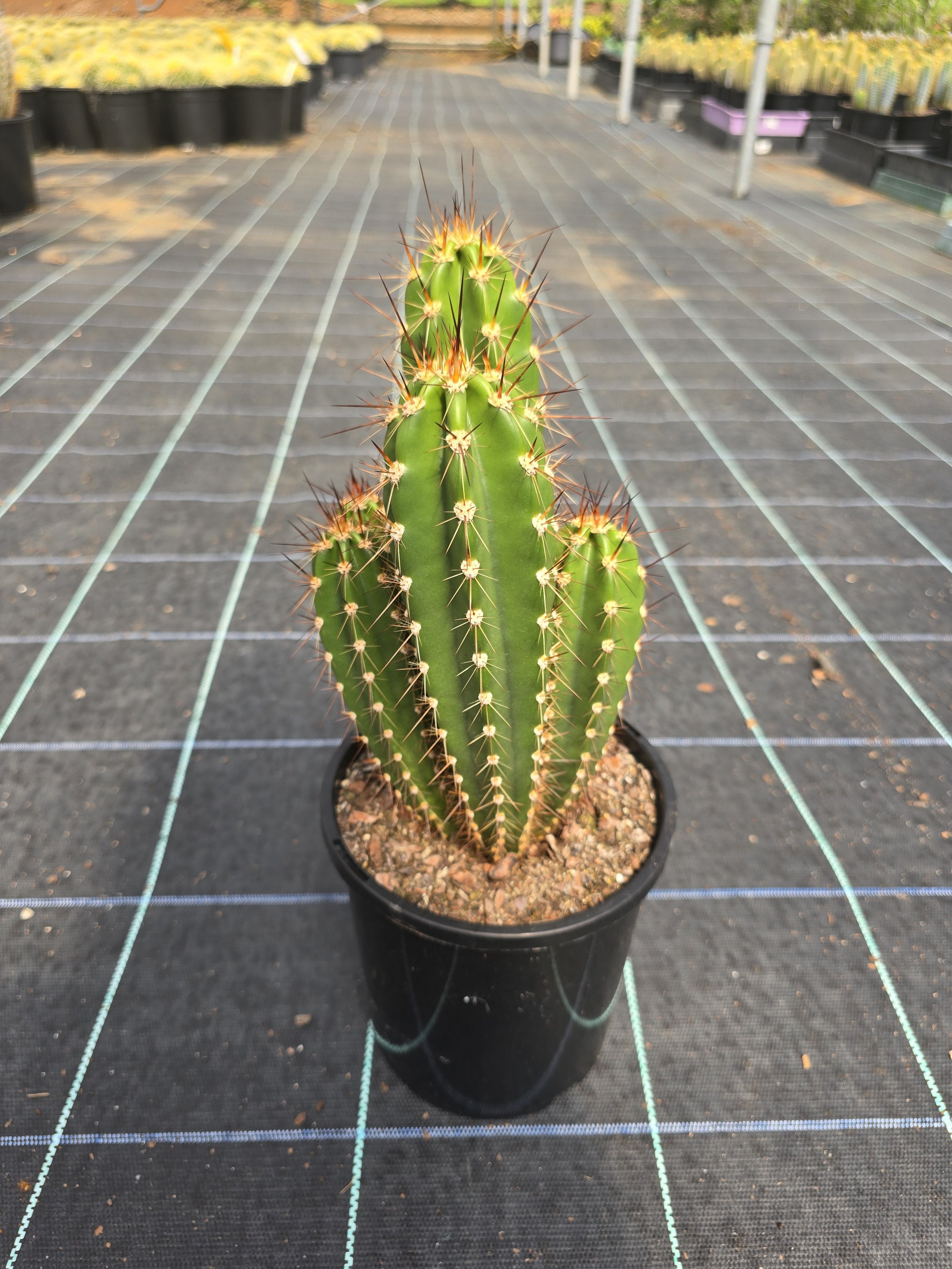 Image 1 of 1
Image 1 of 1


Neocardinesia herzogiana
Neoraimondia herzogiana, also known as the "Baseball Bat Cactus" or "Caripari," is a remarkable columnar cactus native to Bolivia. It thrives in arid, high-altitude regions, particularly in the departments of Cochabamba, Chuquisaca, Santa Cruz, and Tarija, at elevations ranging from 600 to 1,900 meters. cactusjungle.com+1myplantin.com+1de.wikipedia.org+2en.wikipedia.org+2es.wikipedia.org+2
🌵 Botanical Description
Growth Habit: This cactus exhibits a tree-like, candelabra-shaped form, often branching midway up its trunk. It can attain impressive heights of up to 15 meters (approximately 50 feet), with stems measuring 15–20 cm in diameter. cactusjungle.com+2plants.grubbandnadler.com+2en.wikipedia.org+2en.wikipedia.org
Ribs and Spines: The plant features 6 to 7 prominent ribs. Each areole bears 3 to 5 central spines, which can be 6–10 cm long, surrounded by 7 to 10 radial spines measuring 1–2 cm. es.wikipedia.org+2en.wikipedia.org+2de.wikipedia.org+2
Flowers: Neoraimondia herzogiana produces funnel-shaped flowers that are white or pink, measuring up to 6 cm in diameter. These flowers typically bloom in spring and winter. plantlust.com
Fruit: Following flowering, the cactus yields edible, ovoid fruits that are yellowish-brown and covered with small tufts of short, bristle-like spines. The fruits are sweet and tasty, measuring about 5–6 cm in length and 5 cm in diameter. en.wikipedia.org
🌱 Cultivation and Care
Light: Prefers full sun exposure.
Watering: Requires minimal watering; allow the soil to dry out completely between waterings.
Soil: Thrives in gritty, well-drained soils.plantlust.com
Temperature: Suitable for USDA zones 9a to 11. plantlust.com
Propagation: Can be propagated from seeds or cuttings. selinawamucii.com
🌍 Ecological and Cultural Significance
In its native habitat, Neoraimondia herzogiana plays a vital role in the ecosystem. Its fruits are consumed by local wildlife and are also appreciated by humans for their sweet taste. The plant's towering presence contributes to the unique landscape of the Bolivian Andes.
Neoraimondia herzogiana, also known as the "Baseball Bat Cactus" or "Caripari," is a remarkable columnar cactus native to Bolivia. It thrives in arid, high-altitude regions, particularly in the departments of Cochabamba, Chuquisaca, Santa Cruz, and Tarija, at elevations ranging from 600 to 1,900 meters. cactusjungle.com+1myplantin.com+1de.wikipedia.org+2en.wikipedia.org+2es.wikipedia.org+2
🌵 Botanical Description
Growth Habit: This cactus exhibits a tree-like, candelabra-shaped form, often branching midway up its trunk. It can attain impressive heights of up to 15 meters (approximately 50 feet), with stems measuring 15–20 cm in diameter. cactusjungle.com+2plants.grubbandnadler.com+2en.wikipedia.org+2en.wikipedia.org
Ribs and Spines: The plant features 6 to 7 prominent ribs. Each areole bears 3 to 5 central spines, which can be 6–10 cm long, surrounded by 7 to 10 radial spines measuring 1–2 cm. es.wikipedia.org+2en.wikipedia.org+2de.wikipedia.org+2
Flowers: Neoraimondia herzogiana produces funnel-shaped flowers that are white or pink, measuring up to 6 cm in diameter. These flowers typically bloom in spring and winter. plantlust.com
Fruit: Following flowering, the cactus yields edible, ovoid fruits that are yellowish-brown and covered with small tufts of short, bristle-like spines. The fruits are sweet and tasty, measuring about 5–6 cm in length and 5 cm in diameter. en.wikipedia.org
🌱 Cultivation and Care
Light: Prefers full sun exposure.
Watering: Requires minimal watering; allow the soil to dry out completely between waterings.
Soil: Thrives in gritty, well-drained soils.plantlust.com
Temperature: Suitable for USDA zones 9a to 11. plantlust.com
Propagation: Can be propagated from seeds or cuttings. selinawamucii.com
🌍 Ecological and Cultural Significance
In its native habitat, Neoraimondia herzogiana plays a vital role in the ecosystem. Its fruits are consumed by local wildlife and are also appreciated by humans for their sweet taste. The plant's towering presence contributes to the unique landscape of the Bolivian Andes.